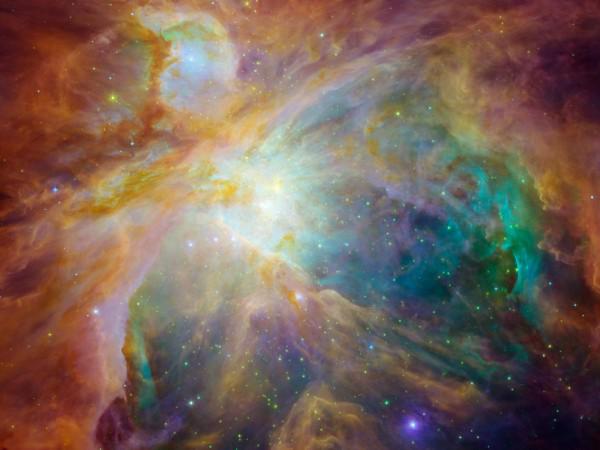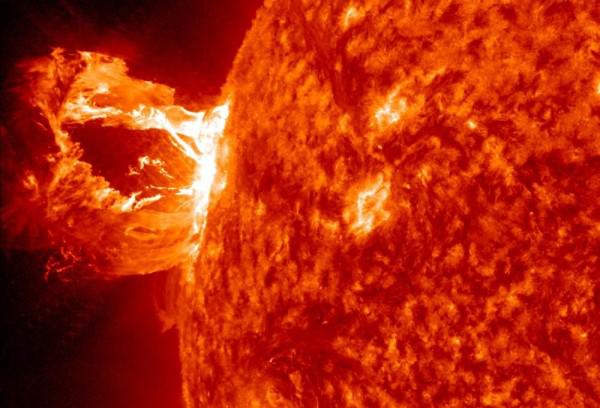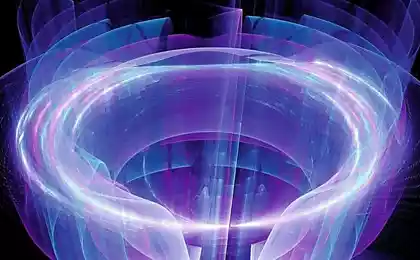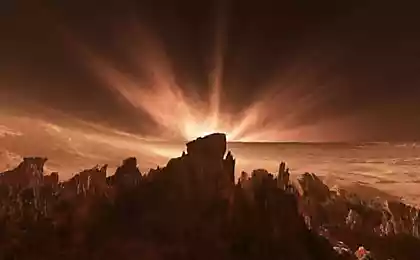1123
Space in April (a review of the events of the month)
April was a very cosmic. Along with the next celebration of the day of astronautics in North America sent the final space shuttle retirement, and in Eurasia landed another group of astronauts to the ISS.
But that's not all. But let's step by step. Let's start with a funny picture that NASA published the fourth day of April. It captures a frozen Martian lava in the form of an elephant's head.

Very close, Mars reconnaissance satellite (MRO) gave a whirlwind the size of the corresponding ordinary terrestrial tornado.

On the same day at the Smithsonian Air and Space Museum of the United States was put up one of the chambers Imax, which flew in the 17th shuttle mission from 1984 to 1998.

And another shot became available the same day. In the photo you see the beginning of the process and the ISS docking of an unmanned cargo spacecraft ATV-3. By the way, this dock we broadcast live.

This picture is called "Chaos in Orion." He shows us the cosmic cloud in the distance from the Earth to 1,500 light-years in the Orion Nebula. In fact, it is a cocoon of dust and gas. For example, green color indicates a high concentration of hydrogen and sulfur.

On April 16 the sun was more powerful flares. Fortunately, they were not directed toward our planet.

ESO has published a snapshot of the disk of cosmic dust around the brightest star in the constellation Piscis - Folmagaut. Scientists have concluded that the dust ring is held by two exoplanets, commensurate with Mars, where one planet is in the ring, and the other outside it.

The space telescope "Hubble" has shown us the sad future of the Sun, photographed Egg Nebula in the stage of the protoplanetary cloud. The planet itself, alas, can not see it for the multi-layered fog.

Another grustnost. Here is a snapshot of the cosmodrome in Tonchhanri, North Korea, with which at the end of March, unsuccessfully tried to launch a satellite «Kwangmyongsong-3."

But the Indians were successfully put into orbit a satellite «Risat-1" from the landfill in Sriharikota. The heavenly body will stay in orbit for about five years, and will pre-empt forest fires, natural disasters and military threat to the country.

On April 17 in the US dopravili the Smithsonian Air and Space Museum legendary shuttle «Discovery».





A day later, they replaced "old man" by the name of «Enterprise» (left), who served as an exhibit here for many years.

April 14 in a legitimate day off, American Dan Burbank gave a guitar concert at the ISS space :)

And two weeks later, Dan (second photo) together with Anton Shkaplerovym (first photo) and Anatoly Ivanishin landed near the town of Arkalyk, Kazakhstan.


At about eight in the morning on April 22 in the sky over the southwestern United States was seen burning a falling meteor. Photo taken in the state of Nevada.

In equatorial Mars «MRO» recorded lava flows strange spiral shape.

The Hubble Space Telescope has made the perfect shot spiral galaxy NGC 2683, which is located at a distance of 35 million years from Earth, in the northern constellation Lynx. In its shape, NGC 2683 was named the UFO Galaxy.

Another nickname galaxy in the constellation Virgo. It is called the Sombrero Galaxy. To explain why, we believe, is not necessary. However, actually, two galaxies and closed in the other one.

April 13 published a comparative analysis of the images of the planet Uranus, which showed two bright spots. According to one hypothesis, we have the aurora.

By the way, on the Earth auroras are still visible. Picture taken third in April in northern Norway.

The brightest spot - Moscow. In the distance, on the right you can see the aurora. As you know, the picture is taken from the ISS.

Photo: ESA, NASA
About this we saw last April. Once again, all with the last Day of Cosmonautics, and often look to the sky;)
But that's not all. But let's step by step. Let's start with a funny picture that NASA published the fourth day of April. It captures a frozen Martian lava in the form of an elephant's head.

Very close, Mars reconnaissance satellite (MRO) gave a whirlwind the size of the corresponding ordinary terrestrial tornado.

On the same day at the Smithsonian Air and Space Museum of the United States was put up one of the chambers Imax, which flew in the 17th shuttle mission from 1984 to 1998.

And another shot became available the same day. In the photo you see the beginning of the process and the ISS docking of an unmanned cargo spacecraft ATV-3. By the way, this dock we broadcast live.

This picture is called "Chaos in Orion." He shows us the cosmic cloud in the distance from the Earth to 1,500 light-years in the Orion Nebula. In fact, it is a cocoon of dust and gas. For example, green color indicates a high concentration of hydrogen and sulfur.

On April 16 the sun was more powerful flares. Fortunately, they were not directed toward our planet.

ESO has published a snapshot of the disk of cosmic dust around the brightest star in the constellation Piscis - Folmagaut. Scientists have concluded that the dust ring is held by two exoplanets, commensurate with Mars, where one planet is in the ring, and the other outside it.

The space telescope "Hubble" has shown us the sad future of the Sun, photographed Egg Nebula in the stage of the protoplanetary cloud. The planet itself, alas, can not see it for the multi-layered fog.

Another grustnost. Here is a snapshot of the cosmodrome in Tonchhanri, North Korea, with which at the end of March, unsuccessfully tried to launch a satellite «Kwangmyongsong-3."

But the Indians were successfully put into orbit a satellite «Risat-1" from the landfill in Sriharikota. The heavenly body will stay in orbit for about five years, and will pre-empt forest fires, natural disasters and military threat to the country.

On April 17 in the US dopravili the Smithsonian Air and Space Museum legendary shuttle «Discovery».





A day later, they replaced "old man" by the name of «Enterprise» (left), who served as an exhibit here for many years.

April 14 in a legitimate day off, American Dan Burbank gave a guitar concert at the ISS space :)

And two weeks later, Dan (second photo) together with Anton Shkaplerovym (first photo) and Anatoly Ivanishin landed near the town of Arkalyk, Kazakhstan.


At about eight in the morning on April 22 in the sky over the southwestern United States was seen burning a falling meteor. Photo taken in the state of Nevada.

In equatorial Mars «MRO» recorded lava flows strange spiral shape.

The Hubble Space Telescope has made the perfect shot spiral galaxy NGC 2683, which is located at a distance of 35 million years from Earth, in the northern constellation Lynx. In its shape, NGC 2683 was named the UFO Galaxy.

Another nickname galaxy in the constellation Virgo. It is called the Sombrero Galaxy. To explain why, we believe, is not necessary. However, actually, two galaxies and closed in the other one.

April 13 published a comparative analysis of the images of the planet Uranus, which showed two bright spots. According to one hypothesis, we have the aurora.

By the way, on the Earth auroras are still visible. Picture taken third in April in northern Norway.

The brightest spot - Moscow. In the distance, on the right you can see the aurora. As you know, the picture is taken from the ISS.

Photo: ESA, NASA
About this we saw last April. Once again, all with the last Day of Cosmonautics, and often look to the sky;)























